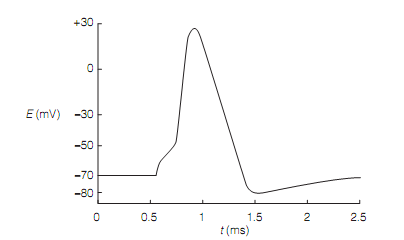Action potentials
The Neurons are naturally excited either by the cascade of synaptic inputs onto their dendrites and cell body from other neurons or by receptor potentials produced by sensory organs. These stimuli correspond to the injection of an inward current into the neuron and cause its membrane potential to drop, which is, to become less inside -negative. This is known as depolarization. If a neuron is depolarized in a sufficient amount it will fire an action potential (i.e., nerve impulse). The Intracellular recording of a nerve impulse as shown in figure shows that the membrane potential rapidly depolarizes to zero, overshoots to about +30 mV and then repolarizes back towards Vm all in less than 1 ms. This comprises the spike of the action potential. Instantly after the spike the neuron membrane potential becomes larger (more inside negative) than the normal resting potential. This is acknowledged as hyperpolarization. After the hyperpolarization below an action potential spike decays over a few milliseconds, and the potential returns to its resting value.

Figure: An intracellular recording of a neuron action potential. The resting membrane potential is about -70 mV.